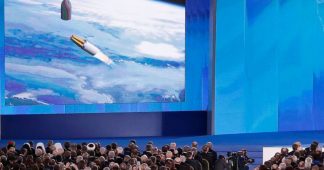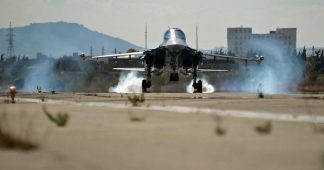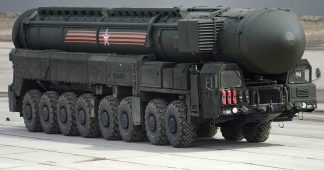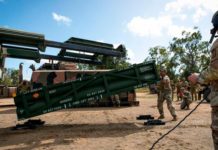16.07.2018
A CNBC report on July 13 cited US intelligence sources saying the Russia’s Kinzhal Kh-47M2 long-range air-to-surface hypersonic missile is “likely be ready for combat as early as 2020”. The weapon has been tested 12 times on a MiG-31 fighter jet and efforts are underway to make it integrated with the Tu-22M3 long-range bomber. Three recent tests have been a success. This month, a target was hit nearly 500 miles away. The missile is going through trials in Southern Military District.
At first, Western experts sounded skeptical about the news that Russia had the weapon, dismissing it as “saber rattling”. Many said it was just hype when Russian President Putin made public the information in early March about some cutting-edge systems only Russia and no other country had. US military officials and lawmakers also downplayed it then.
Mathieu Boulègue, a Chatham House expert on Russia, expressed doubts about Russia’s ability to develop something “new and ground-breaking”. James Acton, a physicist with the Carnegie Endowment for International Peace, told the Daily Beast that other countries simply did not want to develop such systems because “strapping a rocket to a plane doesn’t necessarily make for an effective, scalable weapon.” He believed that being a sort of shortcut hypersonic munition fast enough to evade enemy defenses but unable to accurately strike targets at long range, the Kinzhal was “more useful as a vehicle for propaganda than as a vehicle for high explosives.” Mark Galeotti, a senior researcher at the Institute of International Relations Prague and head of its Centre for European Security, chimed in saying in his Guardian article that “Sounds impressive, terrifying even, but should not be taken entirely at face value. Russian defense industries have a pretty poor track record in delivering advanced systems.”
It’s all changed now. The threat is taken seriously. The US has expedited hypersonic development. As the CNBC story confirms, the US intelligence is closely watching the Kinzhal-related activities.
The Kh-47M2 can be used as a tactical or intermediate strike weapon with a non-nuclear warhead. A range of 1,240 miles and a warhead estimated at between 500 and 700 kilograms turn the missile into an aircraft carrier killer while keeping the delivery means out of range of anti-aircraft weapons. But even without an explosive warhead, its sheer speed exceeding ten times that of the sound is enough to sink a large ship. Compare it to an average cruise missile’s cruising speed of about 850-900 kilometers per hour.
Even the Russian-Indian jointly designed Brahmos air launched cruise supersonic missile with a speed of Mach 2.8 – Mach 3 (3400 – 3700 km/h) can tear a ship apart. The Kinzhal is much more deadly. Its speed also makes it immune to any air defenses. The MiG-31 interceptor boasts a combat radius of 1,500 km. With the Kinzhal mounted, it’ll be able to strike enemy warships at the distance of 3,500 km away from its home base and thus greatly strengthen Russia’s position in the Asia-Pacific region.
The Russian military has already refurbished a number of MiG-31 interceptors to make the Kinzhal achieve initial operational capability.
The US has nothing to counter it with. General John Hyten, the head of Strategic Command, stated during a meeting of the Senate Armed Services Committee that US air defense systems are incapable of countering attacks by hypersonic platforms.
Usually, the Kinzhal’s anti-ship role is emphasized but the missile is a perfect weapon against stationary targets. The US raises hue and cry about Russia’s alleged violations of the INF Treaty. Moscow says the ability of Aegis Ashore BMD system, which is stationed in Romania and planned to be deployed in Poland, to fire Tomahawk surface-to-surface missiles is a flagrant and undeniable breach of the agreement, and it certainly is. In fact, Russia does not need to violate the treaty’s provisions because the combination of Iskander medium range system and MiG-31s armed with the Kinzhal enables it to knock out the NATO infrastructure sites with the same or even higher efficiency than intermediate ground-based missiles.
The aircraft-carried Kinzhal can be easily deployed at far distances in other countries, such as Syria. It can be used to support the operations of the Collective Security Treaty Organization (CSTO) fending off potential attacks from Afghanistan where the Taliban and the Islamic State are engaged in fierce fighting at present.
Finally, the Kinzhal’s entry into service to be carried by the Tu-22M3 bomber would mean Russia has acquired the regional conventional (or nuclear if need be) prompt strike capability. It would also provide the Russian armed forces with the ability to deliver nuclear strikes at intercontinental ranges. The Tu-22M3, which is to enter service in October, is not classified as a heavy bomber and therefore is not covered by the New START Treaty.
Spending much less, Russia gets a lot more than the US due to greater efficiency of its defense programs. As arms control regime is eroding, Moscow is taking measures to guarantee its security even if the expired or torn up agreements will not be replaced by new ones. It is obviously leading in hypersonic arms race. The US has little chance to win the competition but both nations will gain by reviving the strategic dialogue and finding ways to control the process, encompassing the new systems that had not existed at the time the agreements currently in force were concluded.











